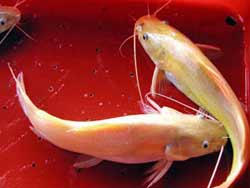 |
Golden Catfish with Shimmering Yellow Color (Photo: TTO) |
The Mystus catfish species are being overfished to the point that some species are becoming rare. The reason: these are native fish species known for their delicious and fragrant meat, which fetch high prices… leading to their depletion. Consequently, the artificial breeding of Mystus species has become a practical necessity…
Among the Mystus species, the Golden Catfish (Mystus sp.) is considered the most attractive. In addition to its relatively large size within the Bagridae family (0.7-1.2kg per fish), the Golden Catfish also boasts beautiful coloration.
Their bodies are covered in a striking golden hue, making them not only a delicacy on dining tables but also suitable for ornamental farming. An interesting feature of this species is that one can see the individual muscle segments inside their bodies with the naked eye.
However, the Golden Catfish seems to be quite rare in the wild. Master Ngo Van Ngoc, a senior lecturer at the Fisheries Department of Ho Chi Minh City University of Agriculture and Forestry, mentioned that this species could be at risk of extinction.
For this reason, over the past five years, the experimental aquaculture station at Ho Chi Minh City University of Agriculture and Forestry has been searching for and studying the artificial breeding of this specialty fish.
The research team at the experimental aquaculture station has successfully stimulated the artificial breeding of the first batch of Golden Catfish using a semi-dry fertilization method.
 |
Large Mystus Catfish (Photo: Q. Thanh) |
From one female fish weighing about 1kg in the wild, the research team obtained over 4,000 six-day-old fry. After 24 days, these fry reached a length of 4.5cm. Currently, about 1,000 of these Golden Catfish are left, now four and a half months old, and measuring 25-30cm in length.
In the near future, the experimental aquaculture station at Ho Chi Minh City University of Agriculture and Forestry will have a breeding stock of Golden Catfish from this fry batch. This will provide a robust source for producing Golden Catfish fry, meeting part of the demand for aquaculture as well as ornamental purposes.
If the most appealing feature of the Golden Catfish is its vibrant color, the Mystus Wyckioides, or Giant Catfish, is attractive for its robust physique. According to scientists, the Giant Catfish is the largest among the Mystus species.
In the wild, there are occasional reports of Giant Catfish weighing 10kg, with some individuals reaching up to 18kg. Under farming conditions, a one-year-old Giant Catfish weighs about 2-2.5kg per fish.
Currently, the artificial breeding process for the Giant Catfish has been completed, and the experimental aquaculture station can transfer this technology to local farmers or businesses in need. Additionally, this research facility is also able to transfer the breeding process for Golden Catfish and the Striped Catfish.
QUOC THANH




















































